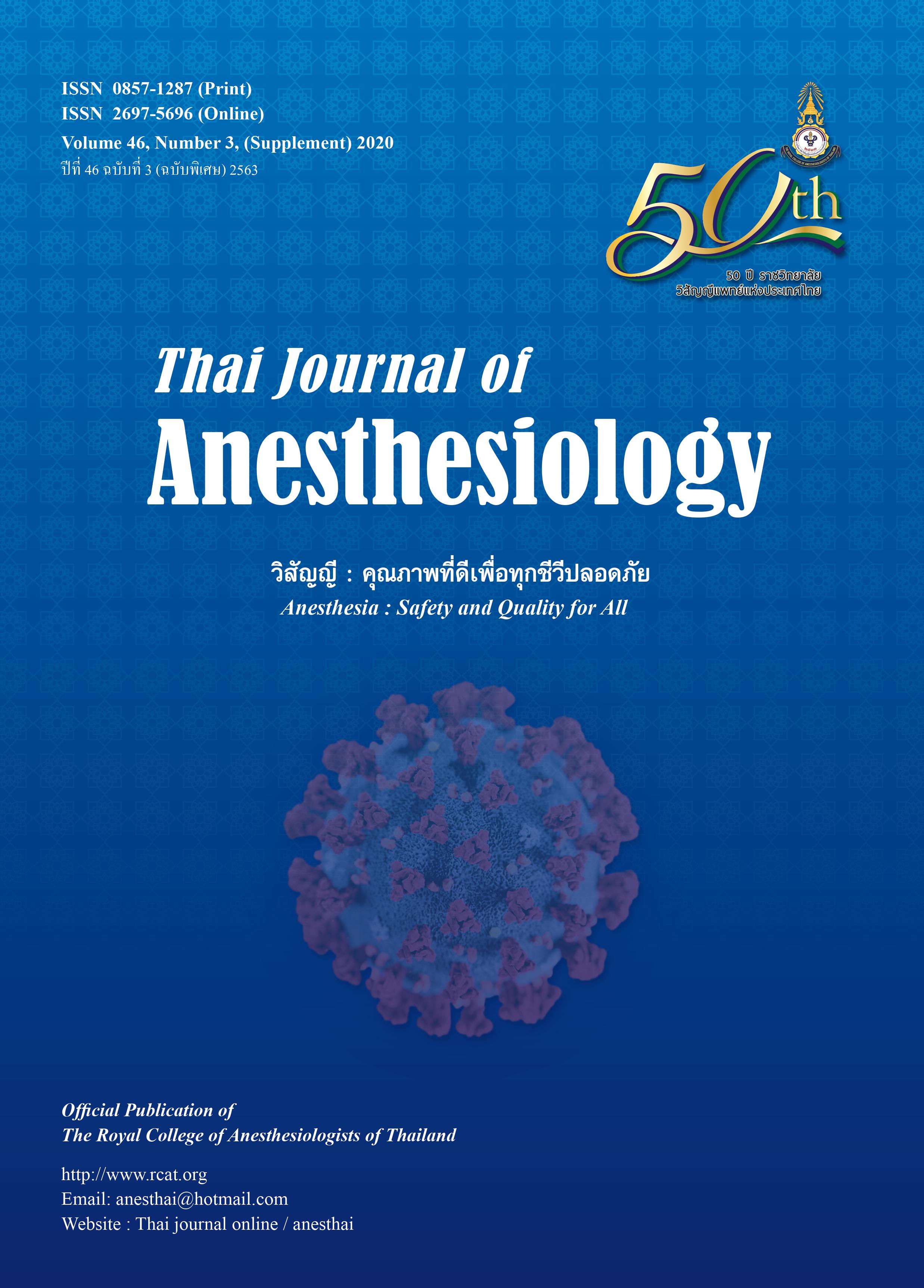Intermediate Volume (15 ml) of Supraclavicular Brachial Plexus Block Combined with Supraclavicular Nerve Block as an Anesthetic Technique for Patients with Proximal End of Humerus Fractures during Corona Virus 2019 Outbreak in Thailand: 3 Cases Report
Main Article Content
Abstract
Proximal humerus fractures increased in frequency
over the past decades. To avoid general anesthesia, the
author used a modified supraclavicular brachial plexus
block with moderate volume (15 ml) combined with
subcutaneous infiltration for supraclavicular nerves as an
anesthetic technique for open reduction and internal
fixation for proximal humerus fractures. Moderate sedation
with various sedatives was added up for patient comfort.
Oxygen supplement was necessary but airway intervention
was not required. The safety means (prevention control
for Corona Virus Disease 2019 according to the hospital
policy) during the procedures were applied for all of the
cases.
Article Details
Section
Case reports
References
1. Iliaens J, Metsemakers WJ, Coppens·S, et al. Regional
anaesthesia for surgical repair of proximal humerus fractures:
a systematic review and critical appraisal. Arch Orthop
Trauma Surg 2019;139:1731-41.
2. Jones MR, Novitch MB, Sen S, Hernandez N, De Haan JB,
Budish RA, Upper extremity regional anesthesia techniques:
A comprehensive review for clinical anesthesiologists. Best
Pract Res Clin Anaesthesiol 2020;34:e13-e29.
3. Park SK, Lee SY, Kim WH, Park HS, Lim YJ, Bahk JH.
Supraclavicular block versus interscalene brachial plexus
block for shoulder surgery: A meta-analysis of clinical control
trials. Anesth Analg 2017;124:636-44.
4. Hussain N, Costache I, Kumar N, Essandoh M, Weaver T,
Wong P, Is supraclavicular block as good as interscalene
block for acute pain control following shoulder surgery?
A systematic review and meta-analysis. Anesth Analg 2020;
130:1304-19.
5. Aliste J, Bravo D, Fernández D, Layera S, Finlayson RJ, Tran
DQ. A Randomized Comparison Between Interscalene and
Small-Volume Supraclavicular Blocks for Arthroscopic
Shoulder Surgery. Reg Anesth Pain Med. 2018;43(6):590-595.
6. Miniato MA, Anand P, Varacallo M. Anatomy, shoulder and
upper limb, shoulder. [Internet]. StatPearls Publishing. March
24, 2020 [Accessed April 30, 2020]. Available from: https://
www.ncbi.nlm.nih.gov/books/NBK536933/
7. Yung EM, Patel N, Brull R, Abdallah FW. Peri-articular infiltration
analgesia for shoulder surgery: a systematic review and
meta-analysis. Anaesthesia 2020. doi: 10.1111/anae.14996.
8. Özkan D, Cemaloğlu S, Catma FM, Akkaya T. Effects of
suprascapular and axillary nerve block on postoperative pain
relief sevoflurane consumption and visual clarity in
arthroscopic shoulder surgery. Agri 2020;32:1-7.
9. Schwenk ES, Viscusi ER, Buvanendran A, Hurley RW, Wasan
AD, Narouze S, Consensus guidelines on the use of intravenous
ketamine infusions for acute pain management from the
American Society of Regional Anesthesia and Pain Medicine,
the American Academy of Pain Medicine, and the American
Society of Anesthesiologists. Reg Anesth Pain Med
2018;43:456-66.
10. Practice recommendations on neuraxial anesthesia and
peripheral nerve blocks during the COVID-19 pandemic
[Internet]. A Joint Statement by the American Society of
Regional Anesthesia and Pain Medicine (ASRA) and
European Society of Regional Anesthesia and Pain Therapy
(ESRA). March 31, 2020 [Accessed April 30, 2020]. Available
from: www.asra.com/page/2905/practice-recommendationson-
neuraxial-anesthesia-and-peripheral-nerve-blocks-dur.
11. Lie SA, Wong SW, Wong LT, MBBS, Wong TGL, Chong SY.
Practical considerations for performing regional anesthesia:
lessons learned from the COVID-19 pandemic. Can J Anesth
2020. doi: 10.1007/s12630-020-01637-0.
12. Uppal V, Sondekoppam RV, Landau R, El-Boghdadly K,
Narouze S, Kalagara HKP. Neuraxial anaesthesia and
peripheral nerve blocks during the COVID-19 pandemic:
a literature review and practice recommendations.
Anaesthesia 2020. doi:10.1111/anae.15105.
anaesthesia for surgical repair of proximal humerus fractures:
a systematic review and critical appraisal. Arch Orthop
Trauma Surg 2019;139:1731-41.
2. Jones MR, Novitch MB, Sen S, Hernandez N, De Haan JB,
Budish RA, Upper extremity regional anesthesia techniques:
A comprehensive review for clinical anesthesiologists. Best
Pract Res Clin Anaesthesiol 2020;34:e13-e29.
3. Park SK, Lee SY, Kim WH, Park HS, Lim YJ, Bahk JH.
Supraclavicular block versus interscalene brachial plexus
block for shoulder surgery: A meta-analysis of clinical control
trials. Anesth Analg 2017;124:636-44.
4. Hussain N, Costache I, Kumar N, Essandoh M, Weaver T,
Wong P, Is supraclavicular block as good as interscalene
block for acute pain control following shoulder surgery?
A systematic review and meta-analysis. Anesth Analg 2020;
130:1304-19.
5. Aliste J, Bravo D, Fernández D, Layera S, Finlayson RJ, Tran
DQ. A Randomized Comparison Between Interscalene and
Small-Volume Supraclavicular Blocks for Arthroscopic
Shoulder Surgery. Reg Anesth Pain Med. 2018;43(6):590-595.
6. Miniato MA, Anand P, Varacallo M. Anatomy, shoulder and
upper limb, shoulder. [Internet]. StatPearls Publishing. March
24, 2020 [Accessed April 30, 2020]. Available from: https://
www.ncbi.nlm.nih.gov/books/NBK536933/
7. Yung EM, Patel N, Brull R, Abdallah FW. Peri-articular infiltration
analgesia for shoulder surgery: a systematic review and
meta-analysis. Anaesthesia 2020. doi: 10.1111/anae.14996.
8. Özkan D, Cemaloğlu S, Catma FM, Akkaya T. Effects of
suprascapular and axillary nerve block on postoperative pain
relief sevoflurane consumption and visual clarity in
arthroscopic shoulder surgery. Agri 2020;32:1-7.
9. Schwenk ES, Viscusi ER, Buvanendran A, Hurley RW, Wasan
AD, Narouze S, Consensus guidelines on the use of intravenous
ketamine infusions for acute pain management from the
American Society of Regional Anesthesia and Pain Medicine,
the American Academy of Pain Medicine, and the American
Society of Anesthesiologists. Reg Anesth Pain Med
2018;43:456-66.
10. Practice recommendations on neuraxial anesthesia and
peripheral nerve blocks during the COVID-19 pandemic
[Internet]. A Joint Statement by the American Society of
Regional Anesthesia and Pain Medicine (ASRA) and
European Society of Regional Anesthesia and Pain Therapy
(ESRA). March 31, 2020 [Accessed April 30, 2020]. Available
from: www.asra.com/page/2905/practice-recommendationson-
neuraxial-anesthesia-and-peripheral-nerve-blocks-dur.
11. Lie SA, Wong SW, Wong LT, MBBS, Wong TGL, Chong SY.
Practical considerations for performing regional anesthesia:
lessons learned from the COVID-19 pandemic. Can J Anesth
2020. doi: 10.1007/s12630-020-01637-0.
12. Uppal V, Sondekoppam RV, Landau R, El-Boghdadly K,
Narouze S, Kalagara HKP. Neuraxial anaesthesia and
peripheral nerve blocks during the COVID-19 pandemic:
a literature review and practice recommendations.
Anaesthesia 2020. doi:10.1111/anae.15105.


